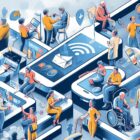2023 Analysis: Q Link Wireless Lifeline Program Feedback

Hey there! Get ready to dive into the 2023 analysis of the Q Link Wireless Lifeline Program. We’ve gathered feedback from participants and conducted a thorough examination.
This article will break down the program’s impact, identify areas for improvement, and discuss future plans.
So, hold on tight as we explore the ins and outs of this lifeline initiative and its potential to make a difference in people’s lives.
Let’s get started!
Key Takeaways
- Q Link Wireless Lifeline Program is a government assistance program that provides free or discounted cell phone service to eligible low-income individuals and families.
- The program is funded through the Universal Service Fund and administered by the FCC.
- Feedback from participants is gathered and analyzed using a structured methodology, with key findings including program accessibility, service quality, customer support, program benefits, and areas for improvement.
- The Lifeline Program has a positive impact on participants’ lives, enhancing social support networks, employment prospects, and access to vital services.
Program Overview and Background
To understand the Q Link Wireless Lifeline Program, you need to know about its program overview and background. The Q Link Wireless Lifeline Program is a government assistance program that provides free or discounted cell phone service to eligible low-income individuals and families. The program is funded through the Universal Service Fund, which is administered by the Federal Communications Commission (FCC). Q Link Wireless is one of several providers that offer Lifeline service.
The Lifeline Program was established in 1985 to ensure that low-income Americans have access to affordable telecommunications services. It was expanded in 2005 to include wireless service, and Q Link Wireless became a Lifeline provider in 2011. The program is designed to help bridge the digital divide by providing eligible individuals with access to essential communication services, such as voice calls, text messages, and internet access.
To be eligible for the Q Link Wireless Lifeline Program, individuals must meet certain income guidelines or participate in a qualifying assistance program, such as Medicaid or Supplemental Nutrition Assistance Program (SNAP). Eligible participants are allowed one Lifeline service per household.
Analysis Methodology and Participant Feedback
Gathering feedback from participants and employing an analytical methodology, we can assess the effectiveness of the Q Link Wireless Lifeline Program. By soliciting input from program participants, we gain valuable insights into their experiences and the impact of the program on their lives. This feedback allows us to identify areas of success and areas for improvement, ensuring that the program continues to meet the needs of its beneficiaries.
To analyze the feedback received, a structured methodology was employed. The feedback was categorized into different themes and analyzed quantitatively and qualitatively. The table below provides a summary of the participant feedback and the key findings from the analysis:
| Feedback Theme | Key Findings |
|---|---|
| Program accessibility | Majority of participants found it easy to access the program |
| Service quality | Positive feedback on the quality and reliability of the service |
| Customer support | Participants expressed satisfaction with the customer support |
| Program benefits | Many participants highlighted the program’s positive impact |
| Areas for improvement | Some participants suggested improvements in program coverage |
Positive Impact of the Lifeline Program
Participants in the Q Link Wireless Lifeline Program have reported a positive impact on their lives. The program, which provides eligible low-income individuals with a free cell phone and monthly minutes, has proven to be beneficial in several ways.
Firstly, many participants have expressed gratitude for having access to a reliable means of communication. The Lifeline Program has allowed them to stay connected with family, friends, and potential employers, enhancing their social support networks and employment prospects.
Secondly, the program has provided a sense of security and peace of mind. Participants feel reassured knowing that they have a means of contacting emergency services in times of need.
Additionally, the Lifeline Program has facilitated access to vital services, such as healthcare providers and government agencies, enabling participants to navigate important aspects of their lives more efficiently.
By providing participants with a lifeline to the outside world, the program has proven to be a valuable resource for those in need.
While the positive impact of the Lifeline Program is evident, there are areas for improvement based on participant feedback.
Areas for Improvement Based on Feedback
Based on feedback from participants, there are several areas for improvement in the Q Link Wireless Lifeline Program. One area that needs attention is the customer service experience. Many participants have expressed frustration with long wait times and difficulty reaching a representative. Improving the efficiency and responsiveness of customer service will enhance the overall satisfaction of program participants.
Another area that requires improvement is the coverage and network reliability. Some participants have reported experiencing dropped calls and poor signal strength in certain areas. Enhancing the network infrastructure and expanding coverage will ensure that participants can rely on their Q Link Wireless service wherever they are.
Additionally, participants have expressed concerns about the limited data and minutes provided under the program. Many feel that the current allocation is insufficient for their needs. Increasing the data and minutes allowance will better meet the communication needs of participants and enhance their overall experience.
Furthermore, the eligibility verification process has been a source of frustration for some participants. Simplifying and streamlining the verification process will reduce delays and ensure that eligible individuals can easily enroll in the program.
Future Plans and Enhancements for the Lifeline Program
To improve the Q Link Wireless Lifeline Program, you can implement future plans and enhancements that address the feedback received from program participants. One important area for improvement is the expansion of coverage.
Many participants expressed dissatisfaction with the limited coverage in certain areas, which hindered their ability to fully utilize the program’s benefits. By investing in infrastructure development and expanding coverage to underserved regions, you can ensure that more individuals have access to the services provided by the Lifeline Program.
Another aspect that requires attention is the quality of customer service. Numerous participants reported experiencing difficulties when contacting customer support or resolving issues with their devices. Enhancements in this area could include hiring additional support staff, improving training programs, and implementing efficient systems for issue resolution. By providing prompt and effective customer support, you can enhance the overall experience for program participants.
Furthermore, it’s crucial to address concerns regarding the eligibility verification process. Some participants mentioned experiencing delays or confusion during the verification process, which resulted in delayed access to the Lifeline benefits. Streamlining the verification process, clarifying eligibility requirements, and providing clear instructions can help eliminate these issues and ensure a smoother experience for program participants.
Lastly, it’s essential to continuously evaluate and adapt the Lifeline Program to keep up with technological advancements and changing needs. This includes staying informed about emerging trends and offering updated devices and services that align with participants’ expectations.
Frequently Asked Questions
How Does the Lifeline Program Work in Terms of Providing Free or Discounted Phone Service?
The lifeline program provides free or discounted phone service. You can qualify based on your income or if you participate in certain government assistance programs. It’s a great way to stay connected without breaking the bank.
What Are the Eligibility Criteria for Individuals to Qualify for the Lifeline Program?
To qualify for the lifeline program, you must meet certain eligibility criteria. These include demonstrating low income, participating in certain government assistance programs, or meeting specific state requirements.
Are There Any Limitations or Restrictions on the Type of Phone Services or Plans Offered Through the Lifeline Program?
There are limitations and restrictions on the type of phone services and plans offered through the Lifeline program. It’s important to understand these limitations to make an informed decision about your phone service.
How Does the Lifeline Program Differ From Other Government Assistance Programs?
The Lifeline program differs from other government assistance programs by specifically providing discounted phone services to eligible individuals. It aims to bridge the digital divide and ensure access to essential communication for low-income households.
What Steps Are Being Taken to Ensure the Lifeline Program Remains Sustainable and Effective in the Future?
To ensure the Lifeline program remains sustainable and effective, steps are being taken. These include regular assessments, implementing feedback from participants, and making necessary adjustments. Efforts are ongoing to improve and maintain the program’s success.



